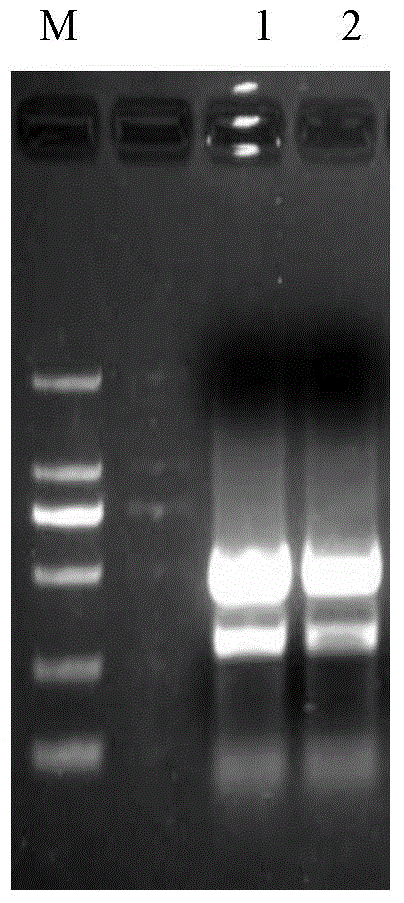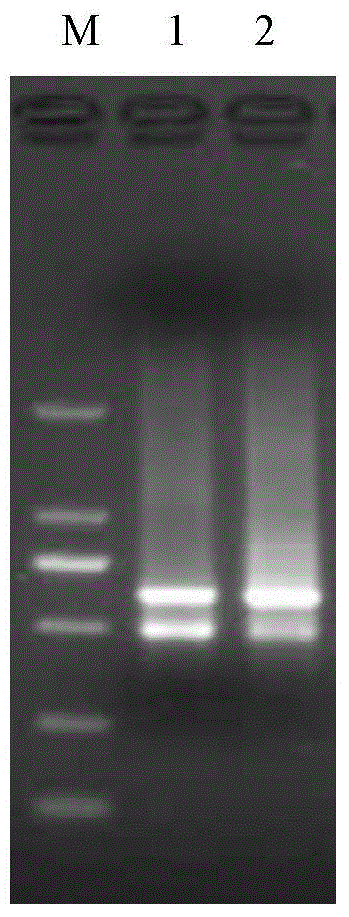Leymus chinensis triosephosphate isomerase gene as well as encoding protein and application thereof
A technology of triose phosphate and encoded protein, applied in the direction of isomerase, application, genetic engineering, etc., can solve the problem of low stress resistance of plants and achieve the effect of improving stress resistance
- Summary
- Abstract
- Description
- Claims
- Application Information
AI Technical Summary
Problems solved by technology
Method used
Image
Examples
specific Embodiment approach 1
[0019] Specific embodiment 1: The nucleotide sequence of Leymus chinensis triose phosphate isomerase gene in this embodiment is shown in SEQ ID No: 1.
[0020] In this embodiment, the Leymus chinensis triose phosphate isomerase gene consists of 1053 bases, including the 5' end untranslated region (1-77), the protein coding region (78-839) and the 3' end untranslated region (840 -1053).
[0021] In this embodiment, the Leymus chinensis triose phosphate isomerase gene is obtained according to the following method:
[0022] 1. Use the RNA extraction kit to extract the total RNA in Leymus chinensis, use the TOYOBO ReverTra Ace-α-kit to reverse-transcribe it into cDNA, and perform PCR amplification with the following primers:
[0023] f 1 , 5'-CGGTGAAGTCAGTGCTGAGATGC-3';
[0024] R 1 , 5'-GCTCCACCAACGAGGAAACCATC-3';
[0025] Recover and purify the PCR product to obtain the conserved region sequence of the LcTPI gene;
[0026] 2. The total RNA of Leymus chinensis in step 1 was...
specific Embodiment approach 2
[0031] Specific embodiment 2: The amino acid sequence of the protein encoded by the triose phosphate isomerase gene of Leymus chinensis in this embodiment is shown in SEQ ID No.2.
[0032] In this embodiment, the encoded protein of Leymus chinensis triose phosphate isomerase gene consists of 253 amino acids, the molecular weight is 26.9KD, and the isoelectric point is 5.57.
specific Embodiment approach 3
[0033] Specific Embodiment Three: Application of Leymus chinensis triose phosphate isomerase gene in this embodiment: Leymus chinensis triose phosphate isomerase gene is introduced into target plants to cultivate transgenic plants with enhanced stress resistance.
[0034] In this embodiment, the target plant is a dicotyledonous plant or a monocotyledonous plant; the stress resistance is resistance to NaCl and methylglyoxal.
[0035] Adopt the following examples to verify the beneficial effects of the present invention:
PUM
| Property | Measurement | Unit |
|---|---|---|
| Molecular weight | aaaaa | aaaaa |
Abstract
Description
Claims
Application Information
 Login to View More
Login to View More - R&D
- Intellectual Property
- Life Sciences
- Materials
- Tech Scout
- Unparalleled Data Quality
- Higher Quality Content
- 60% Fewer Hallucinations
Browse by: Latest US Patents, China's latest patents, Technical Efficacy Thesaurus, Application Domain, Technology Topic, Popular Technical Reports.
© 2025 PatSnap. All rights reserved.Legal|Privacy policy|Modern Slavery Act Transparency Statement|Sitemap|About US| Contact US: help@patsnap.com



